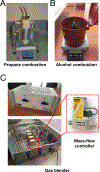Room Indirect Calorimetry Operating and Reporting Standards (RICORS 1.0): A Guide to Conducting and Reporting Human Whole-Room Calorimeter Studies
- PMID: 32841524
- PMCID: PMC7526647
- DOI: 10.1002/oby.22928
Room Indirect Calorimetry Operating and Reporting Standards (RICORS 1.0): A Guide to Conducting and Reporting Human Whole-Room Calorimeter Studies
Abstract
Whole-room indirect calorimeters have been used to study human metabolism for more than a century. These studies have contributed substantial knowledge to the assessment of nutritional needs and the regulation of energy expenditure and substrate oxidation in humans. However, comparing results from studies conducted at different sites is challenging because of a lack of consistency in reporting technical performance, study design, and results. In May 2019, an expert panel was convened to consider minimal requirements for conducting and reporting the results of human whole-room indirect calorimeter studies. We propose Room Indirect Calorimetry Operating and Reporting Standards, version 1.0 (RICORS 1.0) to provide guidance to ensure consistency and facilitate meaningful comparisons of human energy metabolism studies across publications, laboratories, and clinical sites.
© 2020 The Obesity Society.
Figures






Comment in
-
Two Functional Calorimetric Chambers in France Complete the Room Indirect Calorimetry Operating and Reporting Standards (RICORS) 1.0 Guide List.Obesity (Silver Spring). 2021 Apr;29(4):631. doi: 10.1002/oby.23138. Obesity (Silver Spring). 2021. PMID: 33759386 No abstract available.
-
Response to "Two Functional Calorimetric Chambers in France Complete the Room Indirect Calorimetry Operating and Reporting Guidelines (RICORS) 1.0 Guide List".Obesity (Silver Spring). 2021 Apr;29(4):632-633. doi: 10.1002/oby.23135. Obesity (Silver Spring). 2021. PMID: 33759387 No abstract available.
References
-
- Ogle W Aristotle on Youth & Old Age, Life & Death: And Respiration. Longmans, Green, 1897.
-
- Lavoisier AL. Expériences sur la respiration des animaux, et sur les changemens qui arrivent à l’air en passant par leur poumon. Académie des sciences 1780.
-
- Lavoisier AL, marquis de Laplace PS. Mémoire sur la chaleur: Lû à’Académie royale des sciences, le 28 juin 1783. De l’Imprimerie royale, 1783.
-
- Atwater WO, Benedict FG. A respiration chamber, with appliances for the direct determination of oxygen. In: Washington CIo (ed). Carnegie Institution of Washington: Washington, D.C., 1905.
-
- Dauncey MJ, Murgatroyd PR. A direct and indirect calorimeter for studies on energy expenditure in man over 24 h periods [proceedings]. J Physiol 1978;284: 7P–8P. - PubMed
Publication types
MeSH terms
Grants and funding
LinkOut - more resources
Full Text Sources

